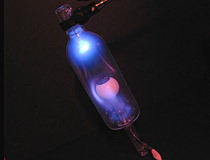A Tesla bulb is a type of early cold cathode light source, one which appears to have never entered commercial production. First built and demonstrated by Nikola Tesla in 1892, a Tesla bulb's defining feature is a total lack of electrodes that penetrate the glass envelope. Instead, a high frequency power supply is used to energize the bulb externally, typically through a graphite or foil conductor that extends through a small glass tube into the center of the bulb. The bulb shown here is a reproduction; unfortunately it appears no original bulbs have survived into the present day. The bulb consists of an evacuated chamber, filled with residual low pressure water vapor, which is penetrated by a tubular glass passage to allow the conductor to reach the center of the bulb. The brightness of the bulb varies considerably once it warms up; the water vapor fill gas will condense into the surface of the glass and must be 'boiled off' for the bulb to reach full intensity. The lack of electrodes penetrating the glass envelope makes a Tesla bulb immune to one of the most common failure modes of other electron tubes; air leakage at the glass-to-metal boundary of the tube's pins. Power requirements are much more complex however; Tesla bulbs require a Tesla coil or some other form of high voltage pulsed power source that can project enough energy through the glass envelope to ionize the tube's fill gas. This was a serious problem in 1892 given the level of technology available, fortunately, the modern experimenter can use a violet ray wand or BD10 high voltage supply to easily activate an electrodeless tube such as this.
It should be noted that Tesla bulbs intended for light output likely included a phosphorescent coating on the inside of the outer globe, which would convert the high voltage discharge into a more usable shade of light. Patent drawings also suggest the final version of the bulb intended for residential use contained a single electrode wire connected to a carbon button in the center of the envelope, which likely lowered the power requirements to ionize the water vapor considerably. Though it is common to consider the Tesla bulb a direct predecessor to the modern florescent tube, florescent tubes contain heated filaments and are in many ways closely descended from the tungsten filament lamps that were in production in the 1930s. Tesla bulbs do have a modern descendant however; the decorative plasma globe. Though the typical plasma globe is filled with high pressure neon instead of low pressure water vapor, the construction and power supply requirements are otherwise almost identical.
More...



